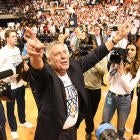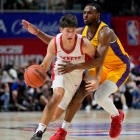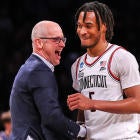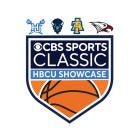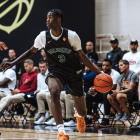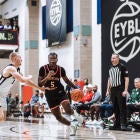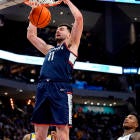Some have gone on to high school coaching careers, others have gotten out of basketball. Some have made their way back to college benches as assistants and others have found basketball jobs outside the NCAA's jurisdiction.
But only a few basketball coaches to receive the dreaded show-cause penalty from the NCAA in the last two decades have gone on to be head coaches after serving their punishment. And none who were assistants when they received the show-cause had reached the pinnacle of being named a major-conference head coach until last month when Steve Forbes accepted the Wake Forest job.
The show-cause penalty is the stiffest punishment a coach can receive for violating NCAA rules. Created for the purpose of preventing coaches penalized by the NCAA from jumping to another school to escape sanctions, a show-cause penalty attaches NCAA penalties to a coach even at a new school. If a school hires a coach under a show-cause, it can only escape the coach's penalties by appealing to the NCAA's Committee on Infractions to "show cause" on why it should not be under the same penalties. Since most schools don't want to be on NCAA probation or penalized for a coach's actions at another school, it dissuades schools from hiring a coach for the duration of the show-cause. And even when the show-cause penalty expires, coaches often struggle under its weight to find employment comparable to what they they had before as they try to rebuild their reputations.
But when Forbes accepted an ACC gig, he completed an improbable comeback that, in a decade's time, took him from a fired Tennessee assistant with the show-cause blemish to a likely seven-figure salary as the leader of a program in one of college basketball's top leagues.
It's arguably the best show-cause redemption story in college basketball history, because unlike Kelvin Sampson and Bruce Pearl, who have recovered well from show-cause penalties, Forbes had no track record as a Division I head coach when he received his punishment from the NCAA in 2011. Yet he found a way to not only survive in the game but to thrive and climb.
The following list is not one any coach would set out to make. But in light of Forbes' redemption, CBS Sports examines college basketball's best show-cause comeback cases of the last 20 years.
Auburn coach Bruce Pearl
Pearl received a three-year show-cause penalty in 2011 as his unprecedented run of success at Tennessee came to an end after an investigation found he lied to NCAA investigators about the program's impermissible contact with prospects. Pearl was 51 when received the penalty. He took a job as vice president of marketing for a grocery distribution firm in Knoxville, Tennessee, but managed to stay involved in the sport as a television analyst while serving his punishment.
With his show-cause penalty set to expire before the 2014-15 season, Pearl took the Auburn job even though several months still remained on his punishment. He has rewarded the Tigers for their faith by establishing the long-suffering program as one of the best in the SEC. Pearl led Auburn to a Final Four appearance in 2019, his fifth season, and had the Tigers poised for another postseason run when the 2019-20 season was canceled with Auburn holding a 25-6 record.
His days of NCAA trouble may not be entirely behind him as Auburn awaits the potential fallout from former assistant Chuck Person's role in the FBI's sting on bribery in college basketball. But for now, Pearl stands as the most-successful show-cause redemption story of the 2000s.
Wake Forest coach Steve Forbes
Time will tell if Steve Forbes if can return the Demon Deacons to the status they held as regulars in the NCAA Tournament for much of the 1990s and early 2000s. But the fact that he even has the chance is a testament to how well he's done in the past decade since being caught up in Pearl's snafu at Tennessee.
Forbes received a one-year show-cause in 2011 for violating the NCAA's "principles of cooperation and honesty" by not cooperating with the investigation into impermissible contact with prospects at Tennessee that took Pearl down. He was 46 when the punishment came down but quickly landed a junior college head coaching job at Northwest Florida State and thrived.
After amassing a 62-6 in two seasons at the JUCO level while his show-cause expired, Forbes returned to NCAA coaching as an assistant at Wichita State. Forbes worked under Shockers coach Gregg Marshall as the program went 35-1 in the Missouri Valley Conference and made two NCAA Tournament appearances during Forbes' time on staff.
He then took the ETSU head coaching job and promptly led the Bucs to five straight seasons of 20 wins or more, culminating with this season's 30-4 mark, before he was hired at Wake Forest.
The case can be made that Forbes has already jumped Pearl as the most-successful show-cause redemption story because he's a couple of rungs higher in the coaching profession than he was when he received the show-cause. Pearl gets the nod for how well he's done at Auburn. But if he's successful at Wake Forest, there will be no doubt Forbes' redemption story stands above the rest.
Houston coach Kelvin Sampson
After two decades as a power conference coach at Washington State, Oklahoma and Indiana, Kelvin Sampson received a five-year show-cause in 2008 after the NCAA uncovered his pattern of making rule-breaking phone calls to prospects. It resulted in his dismissal at Indiana with the Hoosiers holding a 22-4 record in his second season there. Sampson was 53 at the time, and it was unclear what would happen to his coaching career.
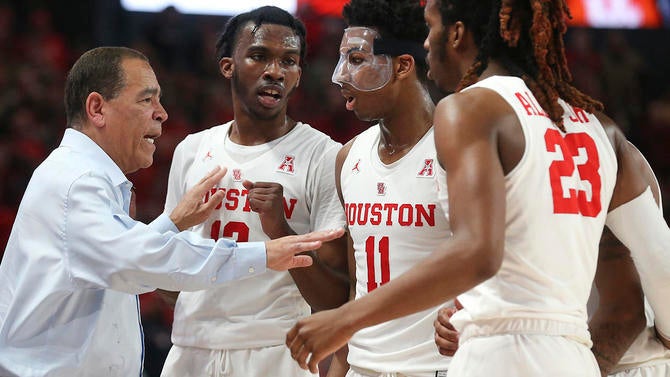
At the time, there had been only one former Division I head coach to receive a show-cause and land another Division I head coaching job on the other side of it. That was Todd Bozeman, who received an eight-year show-cause in 1997 after he was embroiled in controversy at Cal. And Bozeman's return was at a lower level with Morgan State of the MEAC, where he coached from 2006-19.
But Sampson parlayed his otherwise solid reputation in basketball into NBA assistant coaching gigs while he served his penalty and was swiftly hired at Houston in 2014 once the show-cause was up. He's since led the Cougars to five straight seasons of 20 wins or more, including a Sweet 16 appearance in 2019. He's been named AAC Coach of the Year twice, and it's often pointed out that most of the things that got him in trouble are no longer against NCAA rules.
Kent State coach Rob Senderoff
Steve Forbes is the first assistant to become a major-conference head coach following a show-cause, but not the first to get a Division I head coaching job after getting hit with a show-cause while he was an assistant. Rob Senderoff has recovered from a 30-month show-cause to build a winning program in nine seasons as coach at Kent State of the MAC.
Senderoff's punishment came from his time as an assistant under Sampson at Indiana when he participated in the same rule-breaking phone calls with prospects that landed Sampson in trouble. Kent State hired Senderoff as an assistant before the penalty was handed down and stuck by him, allowing him to remain on staff for the duration of his penalty. He was promoted to head coach in 2011 and has led the Golden Flashes to a 181-120 record, including six 20-win seasons and a 2017 NCAA Tournament appearance.
ETSU coach Jason Shay
Jason Shay is the third member of the former Tennessee staff to outlast the show-cause penalty and get a head-coaching gig as he replaces Forbes at ETSU after spending the last five season as an assistant at the school. Like Forbes, he received a one-year show-cause in 2011 for failing to cooperate with the NCAA's investigation into Tennessee's impermissible contact with prospects.
He followed Forbes to Northwest Florida State as an assistant and was also on staff at North Dakota before reuniting with Forbes at ETSU. If he can keep the success rolling at ETSU and parlay it into a bigger job, he could join Forbes the newly established category of those who received show-causes as assistants and have gone on to become head coaches in a major conference.








